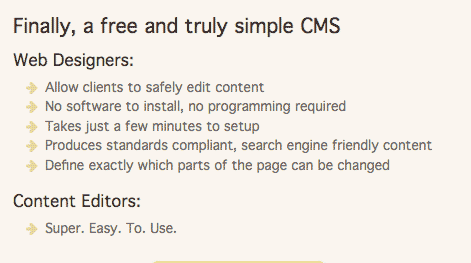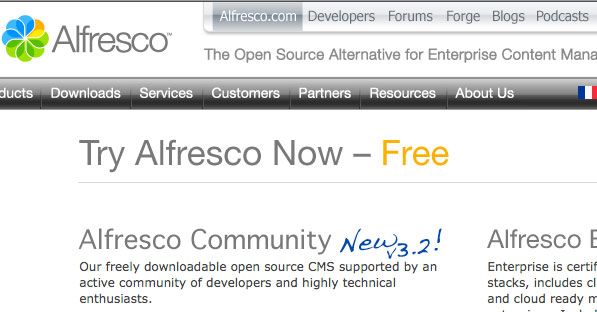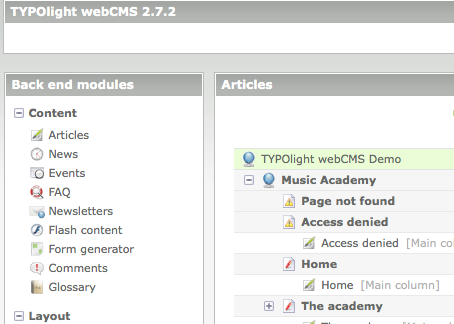CMS Website Design (Content Management System)
CMS or a 'Content Management System' quite literally allows you to control and manage the content within your web site - without technical training. Using this uncomplicated system you can very easily add, delete images and edit text in your web site on the fly. You can also have an unlimited number of pages and a full site-search engine. What's more... with 'Joomla- Web Design' you can have a highly professional CMS web site at a very reasonable price indeed!
In other Word
"A web content management system(web CMS) is a bundled or stand-alone application to create, manage, store and deploy content on Web pages. Web content includes text and embedded graphics, photos, video, audio, and code (e.g., for applications) that displays content or interacts with the user. A web CMS may catalog and index content, select or assemble content at runtime, or deliver content to specific visitors in a requested way, such as other languages. Web CMSs usually allow client control over HTML-based content, files, documents, and web hosting plans based on the system depth and the niche it serves."
List of Content Management System in PHP
There are plenty of options when it comes to picking a content management system for a development project. Depending on how advanced you need the CMS to be, what language it’s built in, and who is going to be using it, it can be a nightmare trying to find the “perfect” CMS for a project.
However, some CMSs have a slight edge over the rest of the competition because of the usability of the software. Some are just easier to install, use and extend, thanks to some thoughtful planning by the lead developers. Here are 10 of the most usable CMSs on the web to use in your next project.
1. WordPress
What is there left to say about WordPress that hasn’t already been said? The PHP blogging platform is far and away the most popular CMS for blogging, and probably the most popular CMS overall. It’s a great platform for beginners, thanks to their excellent documentation
and super-quick installation wizard. Five minutes to a running CMS is pretty good. Not to mention the fact that the newest versions auto-update the core and plugins from within the backend, without having to download a single file.
For those users not familiar with HTML or other markup language, a WYSIWYG editor is provided straight out of the box. The backend layout is streamlined and intuitive, and a new user should be able to easily find their way around the administration section. Wordpres also comes with built-in image and multimedia uploading support.
For developers, the theming language is fairly simple and straightforward, as well the Plugin API.
The WordPress Community is a faithful and zealous bunch. WordPress probably has the widest base ofplugins and themes to choose from. A great part about the WordPress community is the amount of help and documentation online you can find on nearly every aspect of customizing WordPress. If you can dream it, chances are it’s already been done with WordPress and documented somewhere.
2. Drupal
Drupal is another CMS that has a very large, active community. Instead of focusing on blogging as a platform, Drupal is more of a pure CMS. A plain installation comes with a ton of optional modules that can add lots of interesting features like forums, user blogs, OpenID, profiles and more. It’s trivial to create a site with social features with a simple install of Drupal. In fact, with a few 3rd party modules you can create some interesting site clones with little effort.
One of Drupal’s most popular features is the Taxonomy module, a feature that allows for multiple levels and types of categories for content types.
Drupal also has a very active community powering it, and has excellent support for plugins and other general questions.
3. Joomla!
Joomla is a very advanced CMS in terms of functionality. That said, getting started with Joomla is fairly easy, thanks to Joomla’s installer. Joomla’s installer is meant to work on common shared hosting packages, and is a very straightforward considering how configurable the software is.
Joomla is very similar to Drupal in that it’s a complete CMS, and might be a bit much for a simple portfolio site. It comes with an attractive administration interface, complete with intuitive drop-down menus and other features. The CMS also has great support for access control protocols like LDAP, OpenID and even Gmail.com.
The Joomla site hosts more than 3,200 extensions, so you know the developer community behind the popular CMS is alive and kicking. Like WordPress, you can add just about any needed functionality with an extension. However, the Joomla theme and extension community relies more on paid plugins and themes, so if you’re looking for customizations, be ready to pay.
4. ExpressionEngine
ExpressionEngine (EE) is an elegant, flexible CMS solution for any type of project. Designed to be extensible and easy to modify, EE sets itself apart in how clean and intuitive their user administration area is. It takes only a matter of minutes to understand the layout of the backend and to start creating content or modify the look. It’s fantastic for creating websites for less-than-savvy clients that need to use the backend without getting confused.
ExpressionEngine is packed with helpful features like the ability to have multiple sites with one installation of software. For designers, EE has a powerful templating engine that has custom global variables, custom SQL queries and a built in versioning system. Template caching, query caching and tag caching keep the site running quickly too.
One of my favorite features of EE that is the global search and replace functionality. Anyone who’s ever managed a site or blog knows how useful it is to change lots of data without having to manually search and open each page or post to modify it.
ExpresssionEngine is quite different than other previously-mentioned CMS in that it’s paid software. The personal license costs $99.95, and the commercial license costs $249.99.
5. TextPattern
Textpattern is a popular choice for designers because of its simple elegance. Textpattern isn’t a CMS that throws in every feature it can think of. The code base is svelte and minimal. The main goal of Textpattern is to provide an excellent CMS that creates well-structured, standards-compliant pages. Instead of providing a WYSIWYG editor, Textpattern uses textile markup in the textareas to create HTML elements within the pages. The pages that are generated are extremely lightweight and fast-loading.
Even though Textpattern is deliberately simple in design, the backend is surprisingly easy to use and intuitive. New users should be able to find their way around the administration section easily.
While Textpattern may be very minimal at the core level, you can always extend the functionality by 3rd party extensions, mods or plugins. Textpattern has an active developer community with lots of help and resources at their Textpattern.org site.
6. Radiant CMS
7. Cushy CMS
Cushy CMS is a different type of CMS altogether. Sure, it has all the basic functionality of a regular content management system, but it doesn’t rely on a specific language. In fact, the CMS is a hosted solution. There are no downloads or future upgrades to worry about.
How Cushy works is it takes FTP info and uploads content on to the server, which in turn the developer or the designer can modify the layout, as well as the posting fields in the backend, just by changing the style classes of the styles. Very, very simple.
Cushy CMS is free for anyone, even for professional use. There is an option to upgrade to a pro account to use your own logo and color scheme, as well as other fine-grain customizations in the way Cushy CMS functions.
8. SilverStripe
SilverStripe is another PHP CMS that behaves much like WordPress, except has many more configurable options and is tailored towards content management, and not blogging. SilverStripe is unique because it was built upon its very own PHP framework Saphire. It also provides its own templating language to help with the design process.
SilverStripe also has some interesting features built in to the base, like content version control and native SEO support. What’s really unique with SilverStripe is that developers and designers can customize the administration area for their clients, if need be. While the development community isn’t as large as other projects there are some modules, themes and widgets to add functionality. Also, you’ll want to modify the theme for each site, as SilverStripe doesn’t provide much in terms of style, to give the designer more freedom.
9. Alfresco
Alfresco is a JSP is a beefy enterprise content management solution that is surprisingly easy to install. A really useful feature of Alfresco is the ability to drop files into folders and turn them into web documents. Alfresco might be a little bit more work than some of the other CMS and isn’t as beginner-friendly, it certainly is quite usable given the massive power of the system. The administration backend is clean and well-designed.
While Alfresco might not be a great choice for most simple sites, it’s an excellent choice for enterprise needs.
10. TYPOlight
TYPOlight seems to have the perfect balance of features built into the CMS. In terms of functionality, TYPOlight ranks with Drupal and ExpressionEngine, and even offers some unique bundled modules like newsletters and calendars. Developers can save time with the built-in CSS generator, and there are plenty of resources for learning more about the CMS.
If there is a downside to TYPOlight, it’s that it has so many features and configurable options. Even though the backend is thoughtfully organized, there are still a lot of options to consider. But if you’re wanting to build a site with advanced functionality and little extra programming, TYPOlight could be a great fit.










No comments:
Post a Comment